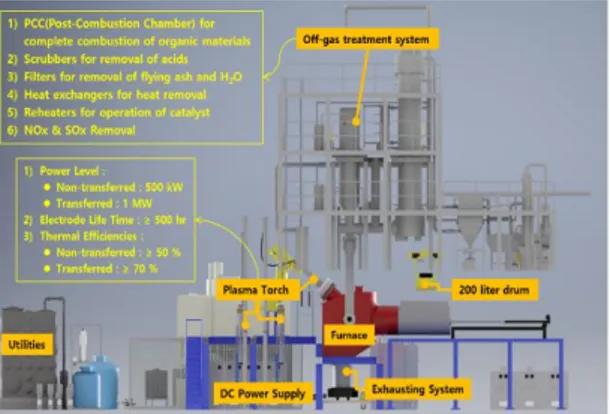2019 ⦽ǎႊᔍᖒ⠱ʑྜྷ⦺⫭ ⇹ĥ⦺ᚁݡ⫭ םྙ᧞Ḳ
203
Construction of a Plasma Melting Facility for Developing the Treatment & Disposal
Technology of Radioactive Waste
Hyun-Je Cho a,*, Mi-Hyun Lee a, and Jun-Ho Seo b a
KHNP Central Research Institute, 70, Yuseong-daero 1312beon-gil, Yuseong-gu, Daejeon, Republic of Korea b
Chonbuk National University, 567 Baekje-daero, Jeonju, Republic of Korea *chohyunje@khnp.co.kr
1. Introduction
In general, radioactive wastes generated in nuclear power plants are stored in a closed 200 L drum container. The wastes stored in drums are collected and stored in various forms, and the wastes comprise a variety of components having characteristic such as flammable, inorganic, etc. Therefore, it is difficult to separate and treat the radioactive waste stored in the 200 L drum separately because of the concern on secondary contamination. Therefore, it is very important that a series of stabilization treatments such as waste input, crushing, combustion and melting, etc. should be continuously made in a melter.
For developing volume reduction method and securing treatment & disposal technology of radioactive waste generated during NPP operation, plasma torch melter technology has been proceed research to treat directly 200 L drum using plasma melting from 2014.
2. Plasma Melting Facility
2.1 Status of WorldwideThe plasma melter melts non-combustible materials such as metals, concrete, and so on, thereby reducing the volume. A large-sized melter for directly processing a 200 L drum scale is used to increase the throughput of a target material, and a megawatt (MW) scale plasma torch is applied in consideration of the heat loss in the melter and the torch. Recently, the plasma torch melter facility in the Kozloduy Nuclear Power Plant in Bulgaria was finished the pre-operation
test in July, 2018 and commercial operation from August started for volume reduction of radioactive waste generated during NPP operation. This melter is discharging molten material with a method by tilting like as plasma facility at Zwilag in Switzerland. In case of Tsuruga nuclear power plant, the pouring of molten is using heating method with an induction heating device on around an outlet of the plasma melter.
2.2 KHNP Facility
Fig. 1 shows a schematic diagram of the constricted plasma melting facility constructed at KHNP/CRI. As shown in this figure, the constructed plasma melting facility primarily consists of a 1.5 MVA class DC power supply (750 A x 2 kV), a convertible plasma torch, a utility system for supplying the various gases and water-coolant, a robot arm for transporting the plasma torch, a high-capacity melter, a drum transportation system and an off-gas treatment system. In a plasma melter developed from present research, the upper surface on which the plasma torch is installed is provided with a constant inclined surface. Accordingly, the torch in melter is smoothly operated, and plasma heat source generated by the torch can easily keep balanced up to the upper portion of the melter. The waste input on upper portion of melter is provided by a small-diameter (approx. 20 cm) inlet pipe and non-drum-shaped combustible waste can be input. The large-scale inlet apparatus is installed at the lateral inlet formed through the side of melter such that the waste drum of 200 L is directly introduced.
220044
2019 ⦽ǎႊᔍᖒ⠱ʑྜྷ⦺⫭⇹ĥ⦺ᚁݡ⫭םྙ᧞Ḳ Fig. 1. A schematic diagram of the MW scale plasmamelting facility constructed by KHNP/CRI.
The melter was designed to take in a 200 liter drum through the drum gate with the melting pool of 200 liter, and built by using the C-MgO composite blocks. Once a 200 liter drum entrained, the plasma torch melts the drum head in non-transferred mode, pouring the wastes contained in the drum. The wastes are layered on the bottom of the melter and heated up by the plasma torch, resulting in the formation of melting pool on the top parts of the layered wastes. If the electrical conductivity of the waste pool is increased enough for passing the arc currents, the operation mode of the torch can be changed into transferred one. Then, the electrical power is elevated for fast and complete melting of the wastes. In addition, the wastes melt is exhausted into the vessel and transported outside the melter as presented in Fig. 1. Finally, these operation processes were shown briefly in Fig. 2 with four pictures, which are taken by operation sequence of a plasma torch, i.e., ignition, non-transferred, hybrid and transferred modes
Fig. 2. Pictures taken during the operation of plasma melting facility for carbon steel melting.
3. Conclusions
A plasma melting facility with electrical output of MW scale was constructed at Central Research Institute of KHNP (Korea Hydro & Nuclear Power Co., Ltd) for producing the produce data and testing the volume reduction of low and intermediate level radioactive waste. The plasma melter was developed with direct processing the 200 L drum, the treatment-possible internal capacity is 2 drums/hr for combus-tible and 1 drum/hr for non-combuscombus-tible. The melter was designed with section type on top plate as cylindrical type, which has a width 2 m, length 2.2 m and height 2.4 m on internal size. In particular, this facility employed a convertible plasma torch system, which is capable of operation mode change from non-transferred to non-transferred modes depending on radioactive wastes such as combustible or non-combustible. By converting the operation mode depending on the electrical conductivity of the radioactive waste, the constructed facility was designed to melt not only the soil and concrete blocks in non-transferred mode but also carbon steels in hybrid or transferred modes. In addition, off-gas treatment system was also designed and connected to the plasma melter, allowing the constructed system to treat the radioactive wastes regardless of whether or not they are combustible within the power level of 1.5 MW.
